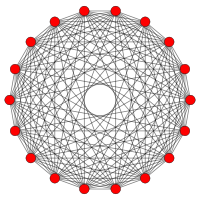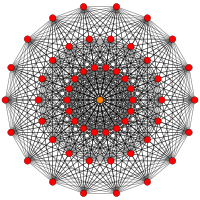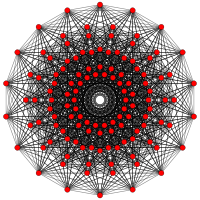Octadecagon
| Regular octadecagon | |
|---|---|
|
A regular octadecagon | |
| Type | Regular polygon |
| Edges and vertices | 18 |
| Schläfli symbol |
{18} t{9} |
| Coxeter diagram |
|
| Symmetry group | Dihedral (D18), order 2×18 |
| Internal angle (degrees) | 160° |
| Dual polygon | self |
| Properties | convex, cyclic, equilateral, isogonal, isotoxal |
An octadecagon (or octakaidecagon[1]) is a polygon with 18 sides and 18 vertices.[2]
A regular octadecagon has a Schläfli symbol {18} and can be constructed as a quasiregular truncated enneagon, t{9}, which alternates two types of edges.
Construction
A regular octadecagon cannot be constructed using a compass and straightedge.[3] However, it is constructible using neusis, or an angle trisector.
Uses

A regular triangle, enneagon, and octadecagon can completely surround a point in the plane, one of 17 different combinations of regular polygons with this property.[4] However, this pattern cannot be extended to an Archimedean tiling of the plane: because the triangle and the enneagon both have an odd number of sides, neither of them can be completely surrounded by a ring alternating the other two kinds of polygon.
Related figures
An octadecagram is an 18-sided star polygon, represented by symbol {18/n}. There are two regular star polygons: {18/5} and {18/7}, using the same points, but connecting every fifth or seventh points. There are also five compounds: {18/2} is reduced to 2{9} or two enneagons, {18/3} is reduced to 3{6} or three hexagons, {18/4} and {18/8} are reduced to 2{9/2} and 2{9/4} or two enneagrams, {18/6} is reduced to 6{3} or 6 equilateral triangles, and finally {18/9} is reduced to 9{2} as nine digons.
| n | 1 | 2 | 3 | 4 | 5 | 6 | 7 | 8 | 9 |
|---|---|---|---|---|---|---|---|---|---|
| Form | Convex polygon | Compounds | Star polygon | Compound | Star polygon | Compound | |||
| Image |  {18/1} = {18} |
.svg.png) {18/2} = 2{9} |
.svg.png) {18/3} = 3{6} |
.svg.png) {18/4} = 2{9/2} |
 {18/5} |
.svg.png) {18/6} = 6{3} |
 {18/7} |
.svg.png) {18/8} = 2{9/4} |
.svg.png) {18/9} = 9{2} |
| Interior angle | 160° | 140° | 120° | 100° | 80° | 60° | 40° | 20° | 0° |
Deeper truncations of the regular enneagon and enneagrams can produce isogonal (vertex-transitive) intermediate octadecagram forms with equally spaced vertices and two edge lengths. Other truncations form double coverings: t{9/8}={18/8}=2{9/4}, t{9/4}={18/4}=2{9/2}, t{9/2}={18/2}=2{9}.[5]
| Quasiregular | isogonal | Quasiregular Double covering | |||
|---|---|---|---|---|---|
 t{9}={18} |
 |
 |
 |
 |
 t{9/8}={18/8} =2{9/4} |
 t{9/5}={18/5} |
 |
 |
 |
 |
 t{9/4}={18/4} =2{9/2} |
 t{9/7}={18/7} |
 |
 |
 |
 |
 t{9/2}={18/2} =2{9} |
Petrie polygons
The regular octadecagon is the Petrie polygon for a number of higher-dimensional polytopes, shown in these skew orthogonal projections from Coxeter planes:
| A17 | B9 | D10 | E7 | ||||
|---|---|---|---|---|---|---|---|
 17-simplex |
 9-orthoplex |
 9-cube |
 711 |
 171 |
 321 |
 231 |
 132 |
References
- ↑ Kinsey, L. Christine; Moore, Teresa E. (2002), Symmetry, Shape, and Surfaces: An Introduction to Mathematics Through Geometry, Springer, p. 86, ISBN 9781930190092.
- ↑ Adams, Henry (1907), Cassell's Engineer's Handbook: Comprising Facts and Formulæ, Principles and Practice, in All Branches of Engineering, D. McKay, p. 528.
- ↑ Conway, John B. (2010), Mathematical Connections: A Capstone Course, American Mathematical Society, p. 31, ISBN 9780821849798.
- ↑ Dallas, Elmslie William (1855), The Elements of Plane Practical Geometry, Etc, John W. Parker & Son, p. 134.
- ↑ The Lighter Side of Mathematics: Proceedings of the Eugène Strens Memorial Conference on Recreational Mathematics and its History, (1994), Metamorphoses of polygons, Branko Grünbaum
External links
| ||||||||||||||||||||||||||
